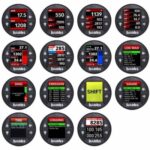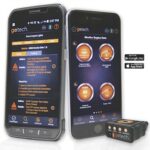Understanding your Volvo’s immobilizer system is crucial, especially for models like the 850, S/V40, S/V70, and XC70 from the mid-90s to early 2000s. This guide will delve into these systems, focusing on how you can use OBDII tools, potentially with your iOS device, to diagnose and manage your Volvo 850 immobilizer.
Locating Your Volvo Immobilizer Control Unit (IMMO Box)
For Volvo 850 and 70 series models, the immobilizer control unit (IMMO box) is typically found on the driver’s side, behind the steering wheel column. In 40 series models, it’s located in the driver’s footwell, behind the plastic trim near the hood release lever.
Volvo Key Transponder and PIN Codes
Originally, the key chip transponders in these Volvo models were designed to last for about 20 years. While chip failures are rare, heavily used keys might exhibit weaker signal strength compared to less frequently used ones. When dealing with these immobilizer systems, having the original PIN code is beneficial. This PIN code, along with other relevant information, is often provided with the vehicle.
For Volvo 850 owners with an OBDII application, it’s possible to remotely generate a new, pre-programmed key chip. This can be programmed to your car, or a ready-to-start key can be created directly if you have the PIN code. This service now extends to IMMO3 models as well, expanding compatibility.
Potential IMMO3 and Battery Related Issues
It’s important to note that in some cases, battery drain or repeated attempts to start the car with a low battery can lead to corruption of the IMMO3 box. This can potentially extend to the engine control module (ECM) as well, causing issues with the immobilizer system. For systems like ME7, M4.4, MSA15.7, MS2000 (S/V40), and Siemens (S/V40), there are methods available to restore functionality if such corruption occurs.
Diagnosing Immobilizer Functionality with OBDII and ELM327
These Volvo immobilizer systems support data reading via OBDII adapters, such as ELM327. This allows you to verify the immobilizer’s operation. Using an OBDII scanner, potentially with an iOS compatible app, you can check crucial parameters.
Key Diagnostic Parameters:
- Transponder Com.: YES – Indicates successful communication with the key transponder.
- Key Code = OK – Confirms that the key has been recognized and validated.
If the key is not recognized, or if there’s a mismatch in coding between the ECM and IMMO, the RESPONSE will be negative. Conversely, if Transponder Com. and Key Code are positive as shown above, the immobilizer is unlikely to be the cause of starting problems, and the ECM should not be shutting down the engine after two seconds. Crucially, QUEST.REC = YES should be displayed, indicating successful communication and understanding between the ECM and IMMO.
Example video of key recognition failure (RESPONSE negative)
Caution Regarding Key Reader Ring Modifications
Attempting to bypass the immobilizer by relocating the transponder chip near the key reader ring is not recommended, especially for systems like SV40. The SV40 reader ring is sensitive to such modifications and may fail to read the chip correctly without additional inductive load between the antenna and chip. Furthermore, the chip’s placement is critical for successful reading, and improper positioning can lead to incorrect data interpretation due to a weak signal. This is due to antenna calibration within the IMMO unit, which varies depending on the Volvo model.
In conclusion, understanding your Volvo 850’s immobilizer system and utilizing OBDII diagnostics, potentially with iOS compatible tools, can be invaluable for troubleshooting and maintenance. If you encounter discrepancies or have a model variation not explicitly covered, it’s always best to seek expert advice.


